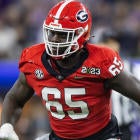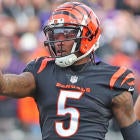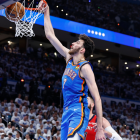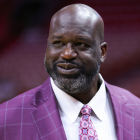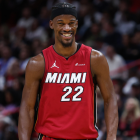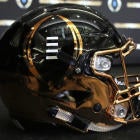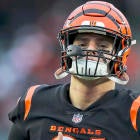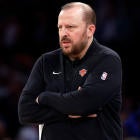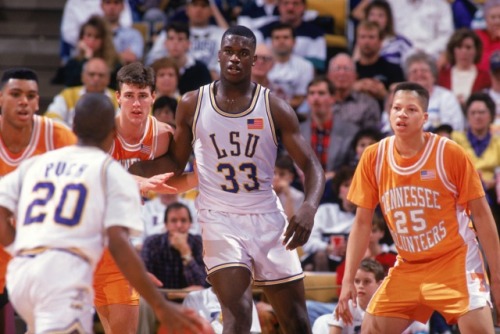
Drafting in sports is an uncertain process. Just take a look at last year's shock No. 1 pick for the Cleveland Cavaliers -- Anthony Bennett -- and it's painfully obviously that landing the top selection doesn't always translate to playoff success, even a few years down the road. But what about back-to-back top picks? Surely landing the right to draft the best player in consecutive drafts should correlate with victories, right?
If the Cavs hold on to the top pick in Thursday's NBA draft, they'll become just the 12th major sports franchise since 1980 to take back-to-back No. 1s. We broke down all the prior instances across the four major sports to see what the Cavs might expect, given their fortuitous lottery luck.
NBA
If there's any solace in the lack of immediate return on last year's Anthony Bennett pick, it's that both times NBA franchises have chosen first overall in consecutive years, they've made the NBA finals within two seasons.
Orlando Magic (1992-1993): The Magic were fortunate enough to win two straight No. 1s in 1992 and 1993, and had little choice but to take Shaquille O'Neal, the massive center out of LSU. O'Neal was so dominant in the paint that he was voted onto the All-Star team as a rookie, the first time that had happened since Michael Jordan in 1985. Despite minimal odds, Orlando earned the top pick in 1993 as well. They took Chris Webber, but traded him to Golden State fifteen minutes later in exchange for Penny Hardaway and three future firsts. The Magic wanted to avoid a crowded frontcourt and thought Hardaway could complement O'Neal inside. It worked, as Orlando went to the Finals in 1995 (and lost to Hakeem Olajuwon's Rockets) while both O'Neal and Hardaway averaged over 20 points. They got swept in the conference finals the next year to the 72-win Bulls, and Shaq bolted for LA. Despite O'Neal's exodus, Orlando nailed its back-to-back chance, although NBA historians will forever wonder what might have come of an O'Neal-Webber tandem in Orlando.
Houston Rockets (1983-1984): Houston earned the right to take Ralph Sampson out of Virginia in 1983, and although the Rockets improved by 15 wins to 29-53, they again earned the top pick in the '84 draft as well and chose the man then known as Akeem Olajuwon -- two spots ahead of Michael Jordan. Not that Houston is complaining. The duo, aptly named "The Twin Towers," guided Houston to 48 wins in its first season together. It was only a year later that they'd lead the Rockets to the finals, where they lost in six games to Boston. Houston was a postseason regular with the massive frontcourt, and although Sampson wasn't there when they finally won it, Olajuwon was the pillar of the franchise during back-to-back titles in '94 and '95.
NFL
The top pick in the NFL draft rarely resurrects a franchise, let alone makes a winner of an expansion team. Such was the case with the Browns in 1999 when they returned to Cleveland. Neither of the two other "back-to-backs" yielded much foundational success either. Football has many more moving parts than the NBA and thus it seems imprudent to directly pin a franchise's hopes on winning the draft. Naturally, with little other choice, that's what the Browns did.
Cleveland Browns (1999-2000): Cleveland took Tim Couch in 1999, beginning a long chain of draft picks for the next decade that failed to pan out. Taken ahead of Donovan McNabb and Ricky Williams, Couch was 22-37 in five years with the Browns, but did manage to guide them to the playoffs in 2002 (still the team's only playoff appearance since returning to the NFL, though Couch was hurt for that loss to the Steelers). Cleveland earned the top pick again on the heels of a 2-14 season and chose Courtney Brown out of Penn State. The DE played an average of less than 10 games per year from 2000 to 2004 before he closed his unfufilling career in Denver. In the three seasons following the back-to-back picks, the Browns averaged seven wins, marking its best stretch of football in the last 15 years.
Cincinnati Bengals (1994-1995): Cincinnati made DT Dan Wilkinson the top pick in 1994, passing on future Hall of Famer Marshall Faulk who was taken with the next pick. Despite the longevity of his 13-year career, Wilkinson never made a Pro Bowl, and he caused more headaches for Bengals management than opposing offensive linemen. The Bengals won just three games in '94 as both the defense and the rushing attack were abysmal. Desperate to improve its ground game, Cincinnati traded from No. 5 to No. 1 to select Ki-Jana Carter out of Penn State. Carter tore his ACL in a preseason game and wound up rushing for over 400 yards just once in his seven-year career. No playoffs, but the Bengals won eight games in 1996 followed by six-straight losing seasons. Cincinnati hasn't traded up in the first round since selecting Carter.
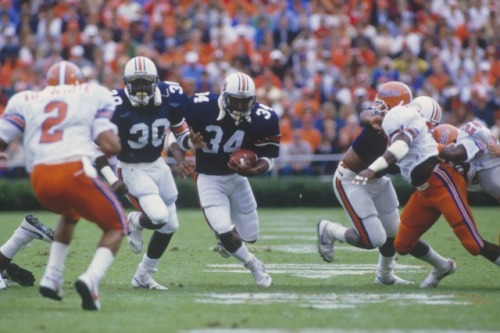
Tampa Bay Buccaneers (1986-1987): What’s worse than drafting consecutive duds? Try drafting a potential marquee player who the team alienated so badly in the pre-draft process that said player refuses to sign. Enter Bo Jackson, arguably the greatest athlete of all time. Story has it that the Bucs flew Jackson in a private jet to work him out while Jackson was still in the midst of his college baseball season at Auburn. The NCAA, despite what the Bucs had assured Jackson, ruled the workout a violation and Jackson was deemed ineligible to play the rest of the season. "I sat down there on the ground and I cried like a baby," Jackson said, who has maintained that the Bucs tried to sabotage his baseball career with the flight so that he'd maintain his focus on football.
Jackson was understandably furious and vowed never to play for Tampa Bay, both before and after the Bucs drafted him in 1986. Jackson held true and signed with the Kansas City Royals, where he was a MLB all-star. Re-entering the draft, he was selected by the Raiders the next year. The Bucs were 2-14 in 1986 and took Vinny Testaverde with the top pick in the next draft. Testaverde eventually became a reliable quarterback but not before he threw 112 interceptions to 77 touchdowns in six losing years as a Buc.
MLB
Considering the slow return and all the various levels of minor league baseball, projecting major league prospects is the hardest among the four major sports.
Houston Astros (2012-2014): The Astros have been the laughingstock of baseball for the past few years, and due to their consistent losing, Houston has dubiously become the first franchise with three-straight No. 1 overall picks. The Astros took high school shortstop Carlos Correa with the top pick in 2012, followed by Stanford pitcher Mark Appel in 2013. Just last month they selected left-handed pitcher Brady Aiken straight out of high school at No. 1. It’s too early to tell the impact these prospects will have in the big leagues (although Appel has struggled thus far in the minors), or what significance the three top picks will have on the franchise. That being said, Correa looks like the real deal. He was hitting .325 with 16 doubles and 20 stolen bases through 61 games while playing for High-A Lancaster of the California League before a recent ankle injury.
Washington Nationals (2009-2010): What will back-to-back 100-loss seasons net you? For the Washington Nationals, awful 2008 and 2009 seasons meant the right to take the most highly coveted pitching prospect in a decade, followed by a five-tool outfielder. Stephen Strasburg and Bryce Harper represented more than a silver lining for the Nats. Those picks spurred the Nats to the playoffs in 2012 on the heels of a 98-win regular season. They ultimately lost to the Cardinals in the division series and missed the postseason in 2013. Still, the return on baseball draft picks isn’t nearly as efficient (or immediate) as other sports and the Nats undoubtedly landed two franchise pillars, albeit fragile ones given their recent injuries.

Tampa Bay Rays (2007-2008): Tampa Bay hit the jackpot with David Price with the first pick in the 2007 draft. The lefty has recorded double digit wins in his five full seasons and his career ERA is hovering at 3.26. But Tampa Bay's top pick in 2008, shortstop Tim Beckham, hasn’t developed nearly as quickly. Now 23, Beckham’s development has been delayed due to an ACL tear last December, just months after making his Major League debut. Buoyed by another first-round pick in 2006 (No. 3), Evan Longoria and Price have built Tampa Bay into postseason regulars. The Rays made it to the postseason in three out of four years from 2010 to 2013, and the year they missed the playoffs, David Price won the Cy Young Award. Price’s days may be numbered in Tampa Bay as the Rays have fallen out of contention and the ace could be used as trade bait.
NHL
The Nordiques had three straight top picks from 1989 to 1991, but no draft would impact the franchise (and the league) like the Eric Lindros trade.
Edmonton Oilers (2010-2012): The Edmonton Oilers haven’t made the playoffs in eight seasons but they did get extremely lucky from 2010-2012 in winning three-straight No. 1 picks. The Oilers became just the second franchise in history (Quebec Nordiques) to land three straight top selections, and they’ve used those drafts to stock the team with solid prospects. In 2010 they took Taylor Hall, a productive winger who excels on power plays. A year later Edmonton selected center Ryan Nugent-Hopkins, who’s been productive when healthy. Their final pick, Nail Yapukov in 2012, had a labor-shortened rookie season albeit a successful one for the Oilers but regressed a bit in his sophomore campaign. There haven’t been any playoff appearances for this trio, but the team is trending upwards.
Ottawa Senators (1995-1996): Ottawa used back-to-back selections in 1995 and 1996 to take two curious No. 1 picks in Bryan Berard and Chris Phillips. Berard never played for Ottawa after refusing to sign, and he was quickly traded to the Islanders for Wade Redden. Berard would go on to win the Calder Trophy, while the Senators built a solid core with Redden, Chris Phillips and Daniel Alfredsson. The Senators were playoff regulars for 11 straight seasons, reaching the Stanley Cup Finals once over that span. Phillips, a defenseman, is still playing for the Senators at age 36.
Quebec Nordiques (1989-1991): The biggest draft bounty as a result of consecutive picks undoubtedly hailed from Quebec when the Nordiques had three-straight No. 1s from 1989 to 1991. The Nordiques selected future Hall of Famer Mats Sundin, who was instrumental in turning the franchise around. Sundin, coupled with Owen Nolan (top pick in 1990), Joe Sakic, Adam Foote, and Mike Ricci to transform the Nordiques from a 52-point team in ’91-92 to a 104-point team in ’92-’93. It was the first time the team made the playoffs with their new core.
The real foundation for Quebec’s success (and eventually Colorado’s following the franchise move in 1995) was with their final No. 1 selection in 1991. The team selected Eric Lindros, despite knowledge that he wouldn’t play for the team for a host of reasons. Lindros was traded to Philadelphia for a massive, massive haul. Directly or indirectly, Lindros eventually netted the Nordiques/Avalanche Peter Forsberg, Mike Ricci, Adam Deadmarsh and Patrick Roy. The Avalanche would at minimum make the conference finals in six of the next seven seasons, including two Stanley Cup titles.













